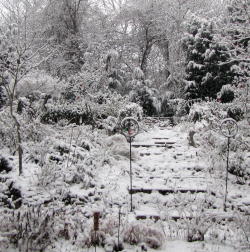
This post is going to show how we planted a round trough made from hypertufa mix in the bonsai style.
Bonsai is the art of aesthetic miniaturization of trees, or of developing woody or semi-woody plants shaped as trees, by growing them in containers. Cultivation includes techniques for shaping, watering, and repotting in various styles of containers. ‘Bonsai’ is a Japanese pronunciation of the earlier Chinese term penzai (盆栽). A ‘bon’ is a tray-like pot typically used in bonsai culture. The word bonsai is used in the West as an umbrella term for all miniature trees in containers or pots.*
For more information about making projects using the mixture of peat moss, perlite and Portland cement, the basics of mixing can be seen by clicking here.
The opening photo is purely ornamental and has absolutely zero to do with the project. It is Camellia sasanqua ‘Chansonette’ now in bloom. We like to begin stories with something pleasing to the eye. Onward.


Several hypertufa troughs were made in late summer to be given as gifts to family members at the Fairegarden family fun get together this Thanksgiving. Several weeks are needed to cure the pots, allowing the lime in the cement to leach out to make a more neutral PH planting container. Since we are once again attempting to make a Bonsai, copper wires have been inserted from the bottom drainage holes to hold the miniature trees in place. The planting depth is shallow, about five inches, so the roots will need some help to stay put during wind, rain and accidental bumping by the gardener. Coffee filters are used to cover the holes to prevent the soil from exiting through the necessary drainage holes that were made at the time of the trough creation. Packaged cactus mix will be the planting medium. Over our many years of gardening, Bonsai has been attempted more times than we like to recall. With the best of intentions, little trees, conifers and Japanese maple seedlings mostly, have been planted lovingly in special pots. Every one has ended in failure, usually something to do with improper watering and/or hardiness miscalculations. With age comes wisdom it is rumored however, and this time there has been much studying of the method online. Here we go.



One reason for the optimistism this time around as we enter the Bonsai realm, besides the nice sized trough planter, is the choice of plant material, dwarf Chinese elms, Ulmus x hollandica ‘Jacqueline Hillier’, (formerly known as U. elegantissima) babies from a generously maturing mother planted on the slope behind the main house. This mother tree is one of two that were given to me by a fellow who owned a landscaping supply business in northeast Tennessee. We had just started a small enterprise of garden design and planting there and had purchased quite a bit of mulch and stone for some of our clients from him. He had cuttings of this small leaved Elm that had come from a tree at the J.C. Raulston Arboretum, he claimed, that he graciously shared with me. One was planted at the house where we now reside in southeast Tennessee where our daughters Semi and Chickenpoet were then living. The other was potted up and made the move with us to Texas and then back to this garden. Both were planted on the slope, one on each side of the center concrete steps, but the one that had been planted in the ground succumbed shortly after being moved. Over the years there have been babies noticed at the base of the remaining specimen, suckers from the roots perhaps. These little ones have been potted, given away and planted here and there in the garden. Some have not survived, but the overall mortality rate has been good.

The cactus mix was spread in the pot to about half full. Rocks from the property were placed in the soil to stabilize the tree roots, with some of the roots on top of the stones. The wires were wrapped tightly but not strangling the two largest trees. These wires will be removed and rewound as the trees grow.

The smaller trees were planted in clusters at the edges with stones holding them in place. More soil was added and the trough was watered well. The Bonsai style planned is the Forest style, with naturalistic pruning to mimic a miniature woodland by using several trees of the same type.

Several waterings later we were satisfied that the soil was saturated completely. The roots of the trees had not been pruned much but some of the roots were cut to allow for draping over the rocks and down into the soil. When the positioning looked promising for future growth, mosses were added, taken from the wall and the older trough planters. This combination of mosses looks a little busy right now, but we’ll see how they weave themselves together, some may have to be removed.

Now we wait. Since it is the sin edge of the wedge of winter now, there will be no pruning done. Selecting the branching and shape desired is a major part of growing Bonsai and we eagerly await the return of warm weather to begin. There is anticipation folded into the patience necessary for success. If any of you gentle readers have some bonsai pruning tips, I would love to hear them.

Inspiration for this project came, in part, from a visit to the North Carolina Arboretum in Asheville in October. The Bonsai display was astounding. The staff had brought inside the more tender specimens. It was noted that the Chinese Elms were allowed to winter over on the protective shelves outside. As often happens, the light bulb illuminated inside the cerebral cortex and shouted, “We can do that”! This remains to be seen. Updates will follow.
For other How To posts written by Fairegarden, look for How To on the sidebar page listing or click here.
Frances
*Information from Wikipedia, click here to visit the page.









Fascinating post Frances. I have long admired bonsai plants and I am not the only one. We will get 2 to 3 customers a week at the flower shop asking to purchase a bonsai. We do not sell them as they are a speciality item and require a lot of care. One day, when I am living full time at Kilbourne Grove, I hope to attempt one as well. Great instructions as usual.
Frances, this looks like an exciting project, I look forward to seeing the results. I think the pot already looks lovely, especially with the moss added. One day I will have the time to try your cement mix, I like so many of the things you have made with it.
Best wishes Sylvia (England)
Hello Frances girl !
I have always found Bonsai absolutely fascinating .. life in miniature is so interesting and to capture a prospective full sized tree and keep it in such a tiny perfect form is amazing .. then add the hypertufa, perfect ! I want one too !! : )
I do have an Austrian Pine (known as our Charlie Brown Christmas tree) held captive in a pot for about 5 years now .. so it is some what a custom sized Bonsai tree considering how HUGE Austrian Pines are supposed to be ? LOL
Joy : )
Very neat project! I’ve only had one bonsai tree which never really made it. That was quite a few years ago. One of the problems was probably that I kept it indoors. So many bonsai plants can be grown outdoors year round. Hypertufa sounds like a great way to pot them!
Frances, Thank you for the step by step instructions and photos…I love knowing! It’s one of the many things that blogging has given me~~access to marvelous information! Love the photos and especially seeing the root draped over the rock. Like Joy, I find bonsai fascinating. gail ps You really put your heart into everything you do….I so admire that about you. xxoo
Thanks for such an informative post – I’ve always wanted to try my hand at making a hypertufa pot and you’ve given me the inspiration I’ve needed!
It is amazing how established this little microcosm already looks Frances. Intriguing and lovely. Carol
Fantastic! I’ve always wanted to try bonsai, on a smaller scale, perhaps. The moss really finishes your planting nicely.
Too much for me to wrap my head around this morning! 🙂 I must need more coffee!
The bonsai info is great and I’ve always wanted to try. I love the hyptertufa container, too.
Cameron
Hi Frances,
What a clever idea for a hypertufa pot. I would like to try this instead of the usual succulents I stick in there. The moss is particularly appealing to me. It makes it looks ancient, which I love. Good job!
Thanks,
Rosey
This makes me want to try bonsai! I’ve seen them at garden shows and am just amazed. I might have to try with some J. maple seedlings from our yard. I love when the roots grow over the rocks like you’ve done. Great post!
I have always admired Bonsai and was amazed at how much work goes into them when we learned about them in one of my horticulture classes. Unfortunately, I do not have the patience to try this myself, but I am thankful for those that do because they are so beautiful.
Combining the hypertufa and bonzai is a good idea. I have to say I have always found bonzai too intimidating to even try it! I love seeing bonzai that other people have grown though.
Love the bonsai in the ‘tufa pots. Love how you have a whole landscape with the stones and moss. Sweet!
You are brave to attempt this. I have always wantted to but I am chicken. I just hate for plants to die in my care. Like that moss you have there in that pot. I can never get moss to grow here. I often wonder why. Good luck with your tree. I can’t wait to see what happens.
Good luck with your project. I have ‘Jacqueline Hillier’ in a pot and it should be an ideal candidate – slow growing with neat tidy leaves. I think I will go looking for moss and rocks to decorate mine. Mine is not Bonsai – I’m not sure I am disciplined enough for the pruning!
Frances, I have always admired bonsais and the gardeners who have the patience to grow them. Like Lisa, I’m too chicken at this point to try them. But I’m imagining some succulents in those containers; wouldn’t they look good? Your tree looks great so far; I’ll be anxious to see how it grows next spring.
Good job! I like the way you added lichens and moss.
Donna
That looks so pretty. I didn’t know that they should be kept outside. It really looks like a natural setting for a forest. Great job.
Fascinating post Frances! I admire your willingness to put this out there for the world to see in spite of past unsuccessful attempts. Best wishes with your bonsai in hypertufa project!
I love bonsai, and will continue to admire them from afar. 🙂
p.s. the camellia is lovely, as is it’s French name. It does look like a little song!
I admire your persistence Frances. That’s what makes you so successful ~ you try, try again. There’s a message in that. I hope this times the charm. The finished container looks very professional and pleasing. I’ve never attempted Bonsai or been tempted to ~ so far it’s an art I just appreciate from afar. Who knows if and when that will change since things often do.
Thank you so much for the lesson, Frances. I was happy to find your hypertufa ball post, and I am excited to try this out. This will be my first hypertufa experience. Then, who knows… maybe a bonsai will be in my future!! 🙂
I like the look of hypertufa. It’s got age to it.
Funnily enough, I was clicking around your blog the other day looking for the hypertufa balls post. Anyway, et voila, so I’ve saved it to favourites.
I wonder whether there’s something that could be used in place of peat moss? I don’t seem to be able to locate it here in France.
The bonsai looks superb, I hope you can do an update sometime as stuff grows ‘in’.
This post is so informative. They are really lovely…Balisha
Good for you to have the patience to do Bonsai. Our Botanical garden has a collection of Bonsai too, must be a growing trend to include this style of gardening. The contorted growth of the trees in bonsai is really interesting. Would be an interesting thing to explore in the pruning process– who to cut and who to allow to grow?
Frances,
I too, visited the Asheville Arborateum in October. It was lovely and inspiring. I too share your failure rate with bonsai, but retain your hope as well. I take heart from your pronouncement that age brings wisdom. By that standard, I should be pretty smart by now 😉
Good luck with your lovely bonsai. I look forward to seeing it age gracefully.
Weeping
Hi Frances – Oh, at first I thought you were going to bonsai a cammelia! That would be truly wacky. 🙂 There is a big Japanese community here in Seattle and I always enjoy seeing bonsai and ikebana (flower-arranging) demonstrations. I guess real bonsai takes, as you’ve seen, immense reserves of knowledge and patience. I hope your latest efforts are successful! I love the moss carpet too. Cheers!
Love your planters !!
Very attractive shape.
Bonsai…what don’t you try ?
Very inspiring! I’ve actually been thinking about trying bonsai on some CA Native trees, but so far, time has been an issue. I won’t start until I know I can really take care of the little tree. Great photos…
I never thought of making my own bonsai pots out of hypertufa. Another one for my project list. Thanks for the idea. And good luck. I too have several failed attempts at bonsai.
Pingback: October Ramblings « Fairegarden
Pingback: Update On The Bonsai In Hypertufa « Fairegarden